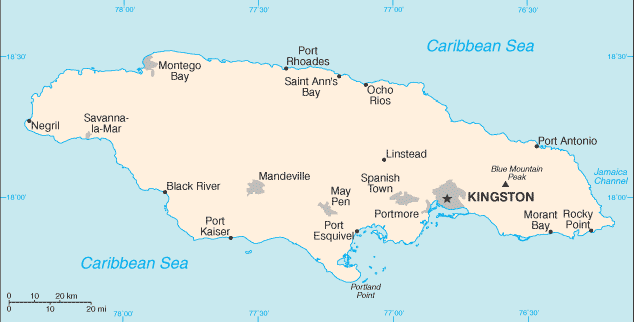|
Jamaica
|

|
Capital: Kingston
Population: 2,948,279
Brief History of Jamaica:
Jamaica was first settled by the Native American tribe the Arawaks. The first European to arrive in Jamaica was Christopher Columbus in 1494. In 1510 Spain settled the island. Unfortunately, disease, war and slavery wiped out the Arawaks. Slaves were brought in from Africa to work the land and grow sugarcane. In 1655 Britain took control of the island from Spain and it became a British colony. When the English arrived, the Spanish fled, but freed their slaves first. The slaves escaped to the mountains. They would become known as the Jamaican Maroons and would fight the British during the 18th century. They established free communities in the mountains in the interior of Jamaica and remained free and independent from the British for many years.
In the early 1900s Jamaica gained more self-government and control from Britain. In 1962 Jamaica became a fully independent country.
The Geography of Jamaica
Total Size: 10,991 square km
Size Comparison: slightly smaller than Connecticut
Geographical Coordinates: 18 15 N, 77 30 W
World Region or Continent: Central America
General Terrain: mostly mountains, with narrow, discontinuous coastal plain
Geographical Low Point: Caribbean Sea 0 m
Geographical High Point: Blue Mountain Peak 2,256 m
Climate: tropical; hot, humid; temperate interior
Major cities: KINGSTON (capital) 580,000 (2009), Montego Bay
The People of Jamaica
Type of Government: constitutional parliamentary democracy
Languages Spoken: English, patois English
Independence: 6 August 1962 (from UK)
National Holiday: Independence Day, 6 August (1962)
Nationality: Jamaican(s)
Religions: Protestant 61.3% (Church of God 21.2%, Seventh-Day Adventist 9%, Baptist 8.8%, Pentecostal 7.6%, Anglican 5.5%, Methodist 2.7%, United Church 2.7%, Jehovah's Witness 1.6%, Brethren 1.1%, Moravian 1.1%), Roman Catholic 4%, other including some spiritual cults 34.7%
National Symbol: green-and-black streamertail (bird)
National Anthem or Song: Jamaica, Land We Love
Economy of Jamaica
Major Industries: tourism, bauxite/alumina, agro processing, light manufactures, rum, cement, metal, paper, chemical products, telecommunications
Agricultural Products: sugarcane, bananas, coffee, citrus, yams, ackees, vegetables; poultry, goats, milk; crustaceans, mollusks
Natural Resources: bauxite, gypsum, limestone
Major Exports: alumina, bauxite, sugar, bananas, rum, coffee, yams, beverages, chemicals, wearing apparel, mineral fuels
Major Imports: food and other consumer goods, industrial supplies, fuel, parts and accessories of capital goods, machinery and transport equipment, construction materials
Currency: Jamaican dollar (JMD)
National GDP: $24,560,000,000
** Source for population (2012 est.) and GDP (2011 est.) is CIA World Factbook.
Back to Geography Home Page
